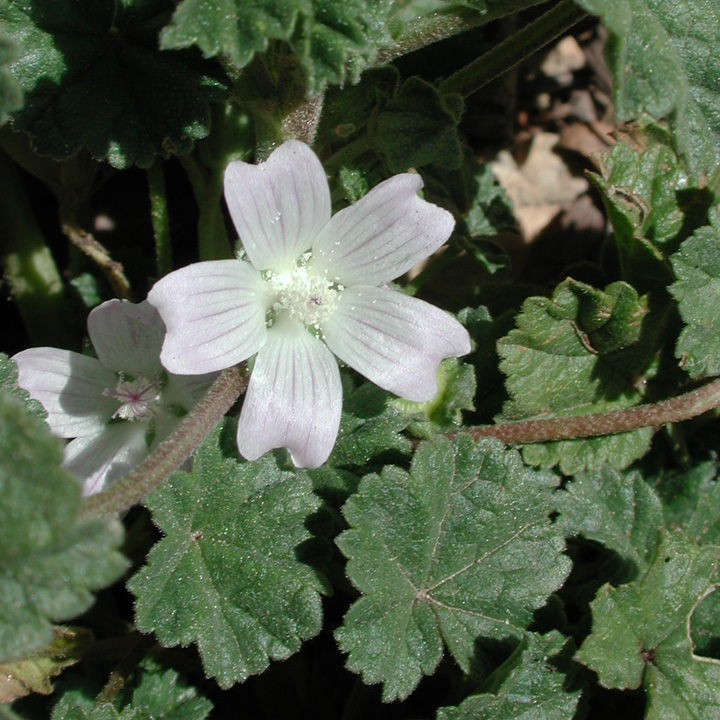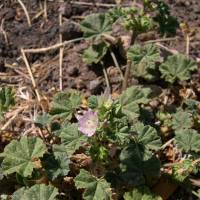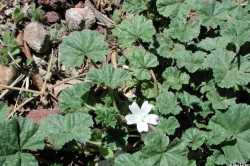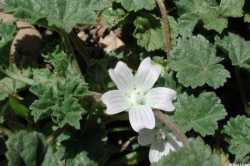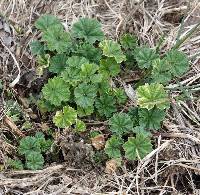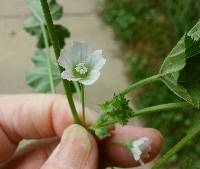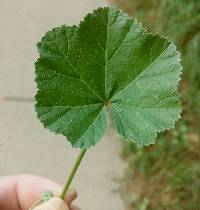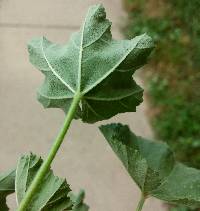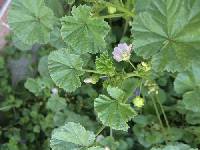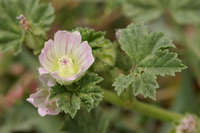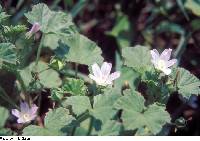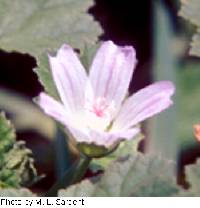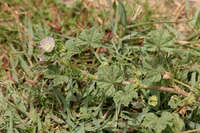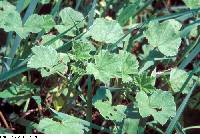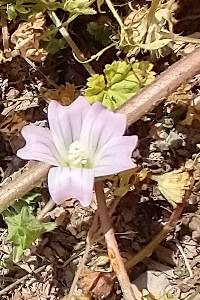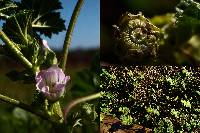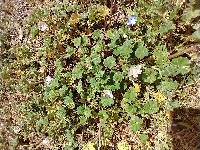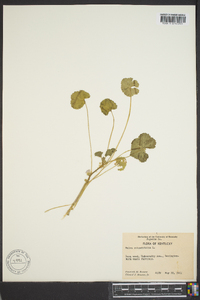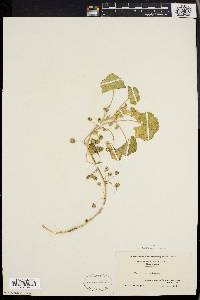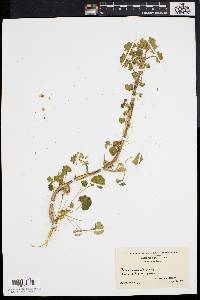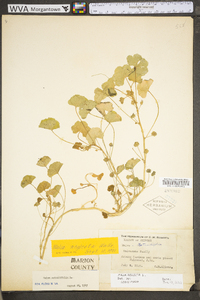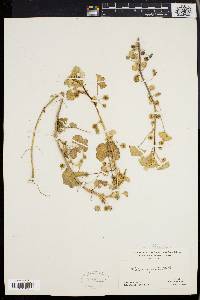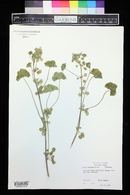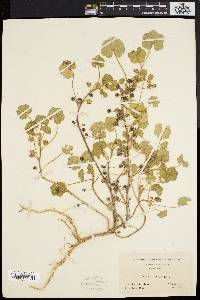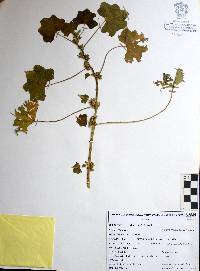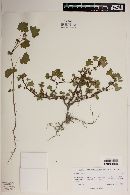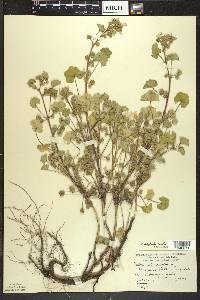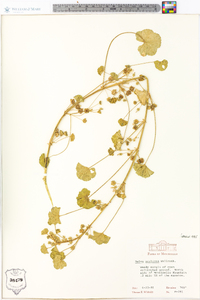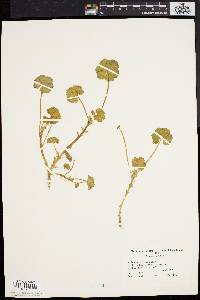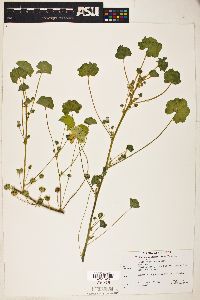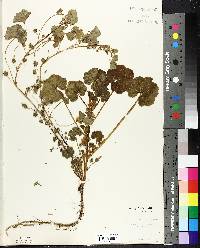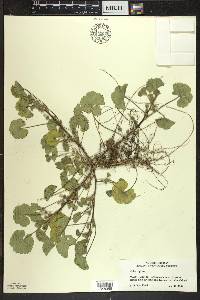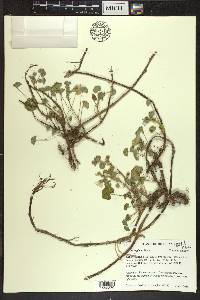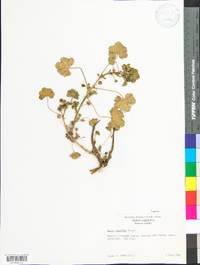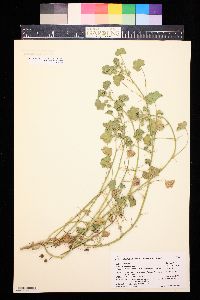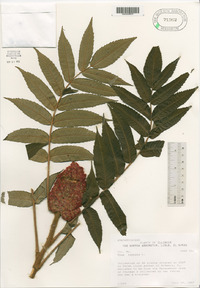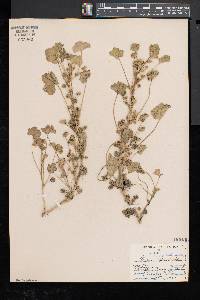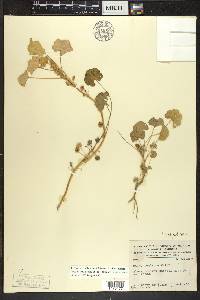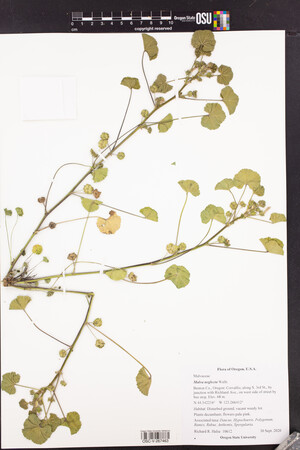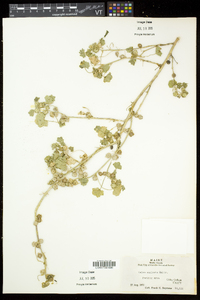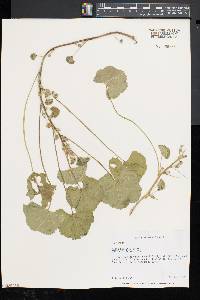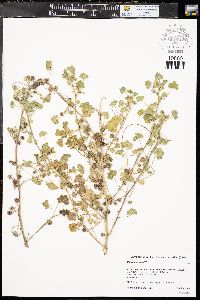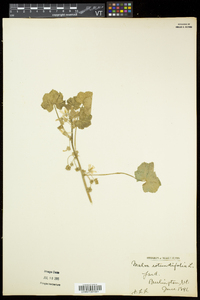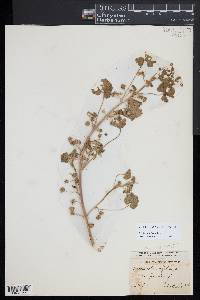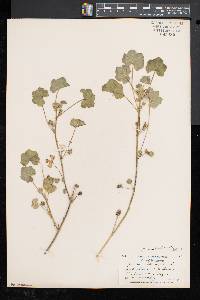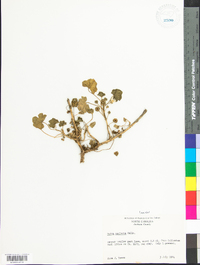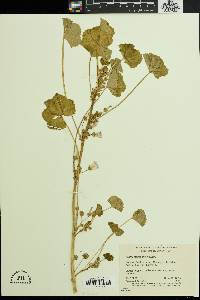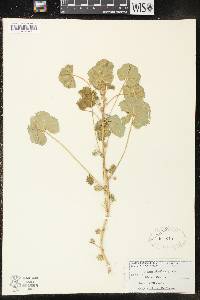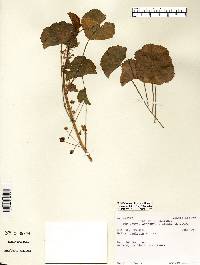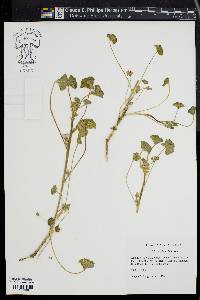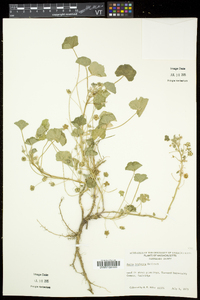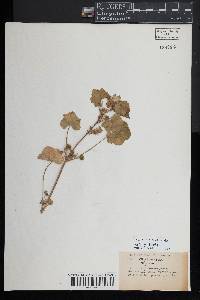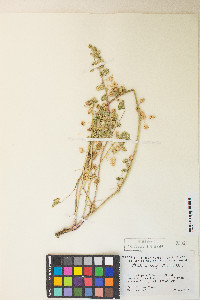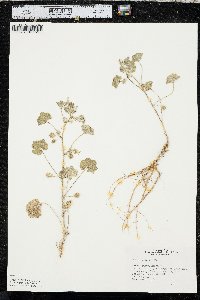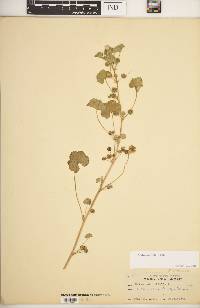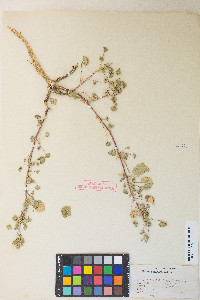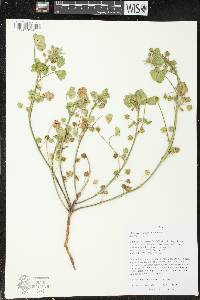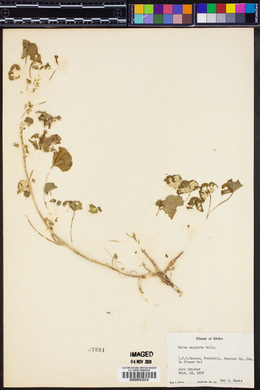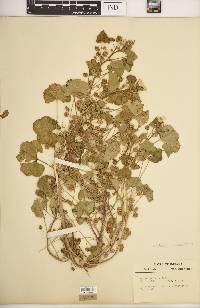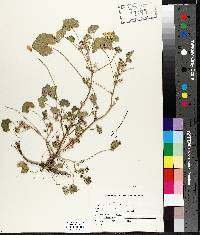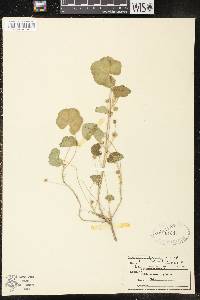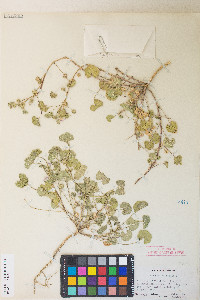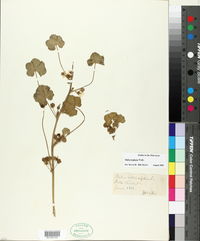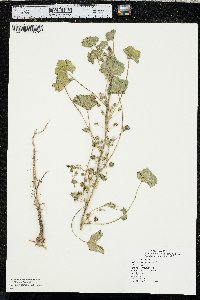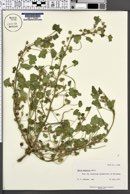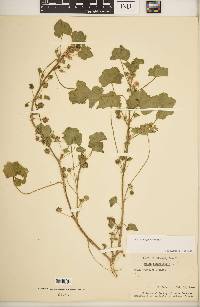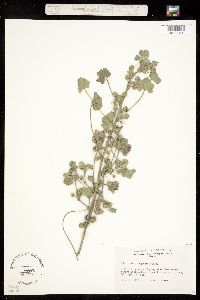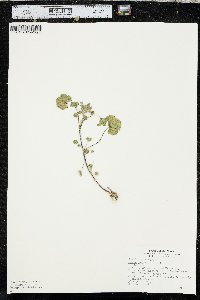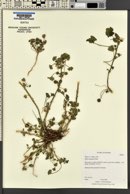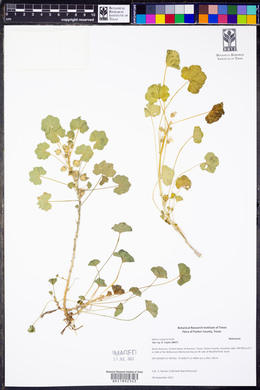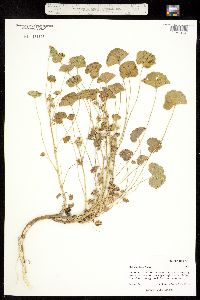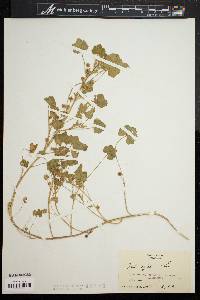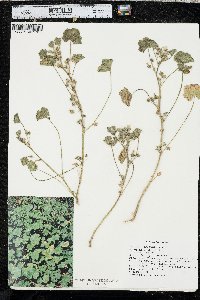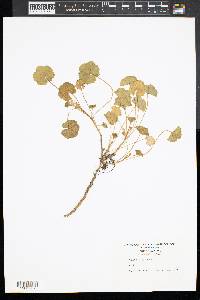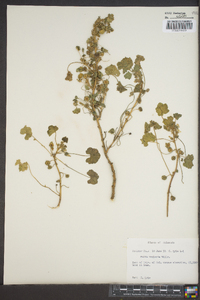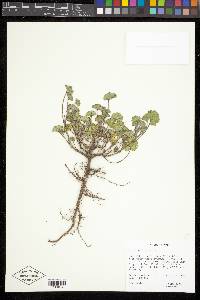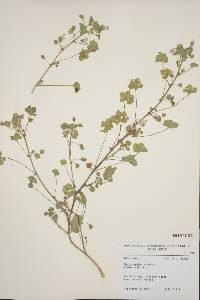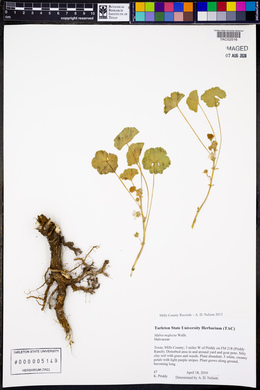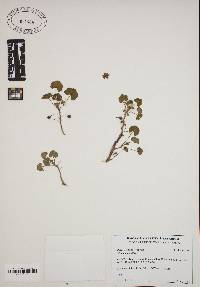
|
|
|
|
Family: Malvaceae
Dwarf Mallow, more...buttonweed, cheeseplant, cheeseweed, common mallow, roundleaf mallow
|
Plant: annual herb; procumbent, with stellate and simple hairs, the simple hairs persisting on older stems Leaves: orbicular or reniform, sometimes weakly lobed, 1-3.5 cm long, crenate. FLOWERS in axillary fascicles on slender pedicels; calyx 4-5 mm long (not accrescent); petals pale lavender to white, 6-11 mm long; staminal column pubescent INFLORESCENCE: axillary fascicles on slender pedicels Flowers: calyx 4-5 mm long (not accrescent); petals pale lavender to white, 6-11 mm long; staminal column pubescent Fruit: FRUITS schizocarpic, usually pubescent; mericarps 12-15, dorsally rounded and smooth; SEEDS solitary Misc: Roadsides and fields; 1400-2600 m (4500-8500 ft); Jul-Sep REFERENCES: Fryxell, Paul A. 1994. Malvaceae. J. Ariz. - Nev. Acad. Sci. Volume 27(2), 222-236. Annual herb to 1 m tall Stem: prostrate to ascending, branched from base, and densely covered with forking or branched hairs. Leaves: alternate, long-stalked, blunt-toothed, circular or kidney-shaped in outline, but with indented base, and five to nine, shallow, wide, somewhat bluntly triangular lobes. Flowers: many, in clusters of three to six in upper leaf axils, long-stalked (stalks to 3 cm), white or slightly tinted with pink or purple, 1.5 - 2.8 cm diameter, radially symmetric, with five somewhat spreading petals, and sepals immediately subtended by three, shorter, linear to oblong bractlets. Sepals: five, but fused for up to half their length, then separating into five widely triangular to egg-shaped lobes fringed with slender bristles. The calyx as a whole is less than half the length of the petals. Petals: five, whitish to pale lilac, hairy, 0.6 - 1.3 cm long (over twice length of sepals), narrowly heart-shaped with narrow base and wider outer edge with obvious center notch, which gives appearance that tip has two rounded lobes. Stamens: numerous, but filaments fused into an elongate tube with the anthers protruding near the top. Pistil: enclosed by the stamen tube, with twelve to fifteen superior carpels (ovule-bearing structures), twelve to fifteen slender styles coming up through center of stamen tube, and ending with exserted, slender stigmas facing inward. Fruit: a ring of twelve to fifteen, one-seeded, hard, dark, finely short- and soft-hairy, about 2.5 mm tall, widely half-circular to plump kidney-shaped, beakless, wedge-like segments (mericarps) enclosed by persistent sepals atop long stalk. The ring of fruit segments looks similar to a peeled tangerine or clementine fruit where the slices or wedges would be analogous to the mericarps. Mericarps typically separate from each other for dispersal, but do not open to release the seed (indehiscent). Similar species: Malva neglecta is most similar to M. parviflora and M. rotundifolia, but both of those species have petals that are only slightly longer than the sepals (if at all), and the mericarps are bumpy and wrinkled on their outsides. Also very similar is M. verticllata, but it differs by having shorter petals (less than twice the length of the sepals), the fruiting stalk is under 1 cm long, and the calyx is greatly enlarged in fruit as compared to when in flower. Flowering: May to October Habitat and ecology: Native to Eurasia and North Africa, now abundant as a weed in gardens and waste places throughout temperate North America. Occurence in the Chicago region: non-native Etymology: Malva means Mallow. Neglecta means overlooked. Author: The Field Museum Fryxell 1993, Jepson 2012, Kearney and Peebles 1969 Duration: Perennial Nativity: Non-Native Lifeform: Forb/Herb General: Herbaceous annuals, stems to 60 cm long, procumbent or prostrate to ascending, herbage with stellate and simple hairs, the simple hairs persisting on older stems, plants with a taproot. Leaves: Alternate, orbicular or reniform, generally shallowly 5-7 lobed or unlobed, 1-6 cm long, with dentate to crenate margins, petioles gradually becoming shorter distally, with papery stipules 3-6 mm long and 2.5 mm wide. Flowers: White to pale lavender, relatively small, with visible, parallel venation on the 5 petals, these 6-11 mm long and oblong with a notch at the tip (emarginate), calyx 4-6 mm long with acuminate lobes not becoming larger with age (accrescent) but sometimes loosely enclosing the schizocarp in fruit, filament tube pale and pubescent, flowers with widely linear, free subtending bractlets 3-6 mm long, flowers borne in groups of 2-6 in axillary fascicles on slender pedicels. Fruits: Disk-like schizocarps with 12-15 mericarps (segments), these smooth or weakly ridged and rounded on top, surfaces usually pubescent. Seeds 1 per segment. Ecology: Found on roadsides and in fields and disturbed areas, from 4,500-10,000 ft (1372-3048 m); flowering May-October. Distribution: Widespread across most of the United States, not found in Mississippi, Louisiana, or Florida. Notes: This handsome species has white flowers with 5 petals, the petals have a couple visible, parallel veins, these sometimes pinkish, the petals are open and more-or less flattened, with a prominent notch at the tips. Look for this species in Coconino, Apache, Navajo, Greenlee, Graham, Gila, Maricopa, and Yavapai counties in Arizona. Ethnobotany: Plant used for painful congestion of the stomach, compound infusion of plants applied as poultice to swellings of all kinds, compound decoction of plants applied as poultice to baby's swollen stomach or sore back, cold compound infusion of leaves applied as poultice to broken bones, flowers put in oil and mixed with tallow for use on sores, and infusion of smashed plant taken to vomit for a love medicine. Etymology: Malva is a Latin name for mallow taken from the Greek malache, or malakos, referring to the leaves and an ointment made from the seeds which was supposed to be soothing to the skin, and neglecta means neglected or overlooked. Synonyms: Malva rotundifolia Editor: LCrumbacher2012 Prostrate to ascending annual or biennial to 1 m, usually branched from the base; lvs long-petioled, orbicular or reniform, 2-6 cm wide, shallowly 5-9- lobed, crenate, with cordate or subcordate base; fls fascicled in the axils, on pedicels to 3 cm; bractlets narrow; pet obcordate, 6-12 mm, white or slightly tinted with pink or purple, twice as long as the sep; mature carpels usually 12-15, rounded on the back and usually finely hairy, not rugose or reticulate, the lateral faces not radially veined, the whole ring of carpels with a crenate outline, the depressed central portion of the head a third as wide as the head; 2n=42. Native of Eurasia and n. Afr., now abundant as a weed in gardens and waste places throughout temperate N. Amer. May-Oct. Gleason, Henry A. & Cronquist, Arthur J. 1991. Manual of vascular plants of northeastern United States and adjacent Canada. lxxv + 910 pp. ©The New York Botanical Garden. All rights reserved. Used by permission. From Flora of Indiana (1940) by Charles C. Deam Local and very rare. Alluvial banks of the Wabash River and moist roadsides. I have had the staminate form in cultivation since 1918 and the pistillate form since 1931. .…… Indiana Coefficient of Conservatism: C = null, non-native Wetland Indicator Status: N/A |
|
|
|

